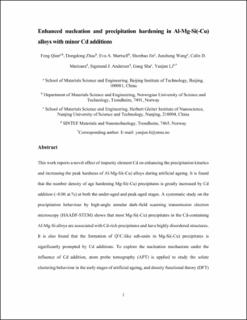| dc.contributor.author | Qian, Feng | |
| dc.contributor.author | Zhao, Dongdong | |
| dc.contributor.author | Mørtsell, Eva Anne | |
| dc.contributor.author | Jin, Shenbao | |
| dc.contributor.author | Marioara, Calin Daniel | |
| dc.contributor.author | Andersen, Sigmund Jarle | |
| dc.contributor.author | Sha, Gang | |
| dc.contributor.author | Li, Yanjun | |
| dc.date.accessioned | 2021-02-09T11:57:41Z | |
| dc.date.available | 2021-02-09T11:57:41Z | |
| dc.date.created | 2020-11-09T16:26:42Z | |
| dc.date.issued | 2020 | |
| dc.identifier.citation | Materials Science & Engineering: A. 2020, 792, . | en_US |
| dc.identifier.issn | 0921-5093 | |
| dc.identifier.uri | https://hdl.handle.net/11250/2726892 | |
| dc.description.abstract | This work reports a novel effect of impurity element Cd on enhancing the precipitation kinetics and increasing the peak hardness of Al–Mg–Si(–Cu) alloys during artificial ageing. It is found that the number density of age hardening Mg–Si(–Cu) precipitates is greatly increased by Cd addition (~0.06 at.%) at both the under-aged and peak-aged stages. A systematic study on the precipitation behaviour by high-angle annular dark-field scanning transmission electron microscopy (HAADF-STEM) shows that most Mg–Si(–Cu) precipitates in the Cd-containing Al–Mg–Si alloys are associated with Cd-rich precipitates and have highly disordered structures. It is also found that the formation of Q'/C-like sub-units in Mg–Si(–Cu) precipitates is significantly promoted by Cd additions. To explore the nucleation mechanism under the influence of Cd addition, atom probe tomography (APT) is applied to study the solute clustering behaviour in the early stages of artificial ageing, and density functional theory (DFT) calculations are used to evaluate the binding energies of different solute-vacancy complexes and therefore the formation kinetics of Mg–Si–Cd clusters. | en_US |
| dc.language.iso | eng | en_US |
| dc.publisher | Elsevier | en_US |
| dc.rights | Attribution-NonCommercial-NoDerivatives 4.0 Internasjonal | * |
| dc.rights.uri | http://creativecommons.org/licenses/by-nc-nd/4.0/deed.no | * |
| dc.title | Enhanced nucleation and precipitation hardening in Al-Mg-Si(-Cu) alloys with minor Cd additions | en_US |
| dc.type | Peer reviewed | en_US |
| dc.type | Journal article | en_US |
| dc.description.version | acceptedVersion | en_US |
| dc.source.volume | 792 | en_US |
| dc.source.journal | Materials Science & Engineering: A | en_US |
| dc.identifier.doi | 10.1016/j.msea.2020.139698 | |
| dc.identifier.cristin | 1846303 | |
| dc.description.localcode | © 2020. This is the authors’ accepted and refereed manuscript to the article. Locked until 25 June 2022 due to copyright restrictions. This manuscript version is made available under the CC-BY-NC-ND 4.0 license http://creativecommons.org/licenses/by-nc-nd/4.0/ | en_US |
| dc.source.articlenumber | 139698 | en_US |
| cristin.ispublished | true | |
| cristin.fulltext | postprint | |
| cristin.qualitycode | 2 | |

